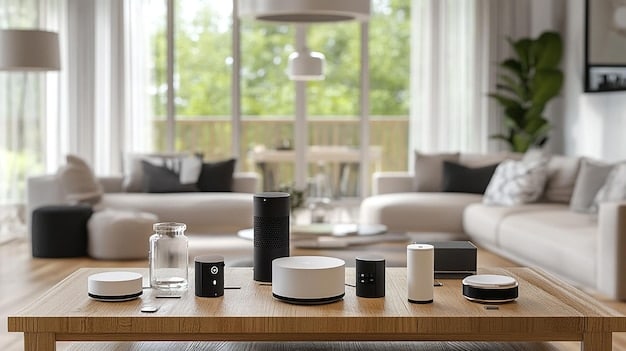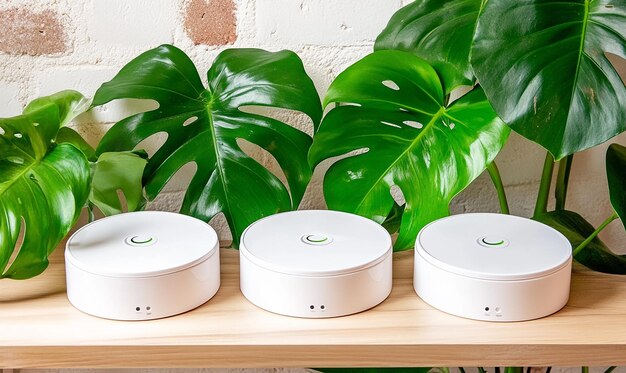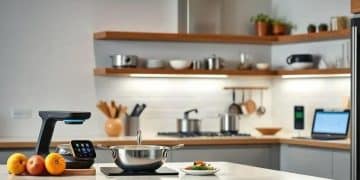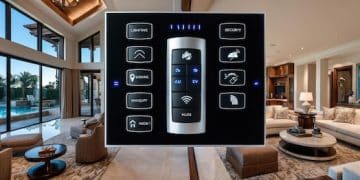Future-Proof Your Smart Home: Upgradeable & Compatible Devices

Future-proofing your smart home involves strategic investments in upgradeable and compatible devices, ensuring long-term functionality and avoiding obsolescence as technology evolves.
Planning a smart home? Consider future-proofing your smart home by investing in devices designed for upgrades and seamless compatibility, saving you from costly overhauls later.
Why Future-Proofing Your Smart Home is Essential
A smart home is more than just a collection of gadgets; it’s an ecosystem. The rapid pace of technological advancement means that today’s cutting-edge devices can quickly become obsolete. This is why future-proofing your smart home with smart choices is crucial.
Future-proofing your smart home involves making strategic decisions about the devices you purchase and how they integrate into your existing setup. The overarching goal is to ensure that your smart home remains functional, relevant, and adaptable for years to come.
The Cost of Obsolescence
Ignoring the concept of future-proofing can lead to a cycle of replacing devices every few years, which can be financially draining. Moreover, integrating new, incompatible systems can be a significant headache.
- Financial Strain: Constantly buying new devices to keep up with technology can be costly.
- Integration Issues: Integrating incompatible devices can lead to a fragmented and frustrating user experience.
- Environmental Impact: The constant disposal of old devices contributes to electronic waste.
Investing in upgradeable and compatible devices upfront can save you money, time, and reduce your environmental impact in the long run. Consider choosing systems designed to evolve.
Understanding Compatibility and Interoperability
The cornerstone of a future-proof smart home is compatibility. Compatibility ensures that devices from different manufacturers can communicate and work together seamlessly. This is largely achieved through adherence to open standards and protocols.
Interoperability refers to the ability of different systems and devices to exchange and use information. When devices are interoperable, they can share data and control functionalities effectively.

Key Protocols and Standards
Several protocols and standards facilitate communication between smart home devices. Understanding these is vital in future-proofing your smart home.
- Wi-Fi: The most common protocol, used for high-bandwidth applications like streaming video.
- Bluetooth: Ideal for short-range communication, commonly used for device pairing and control.
- Zigbee and Z-Wave: Mesh networking protocols designed specifically for low-power smart home devices. These create robust, self-healing networks that can cover a large area.
Look for devices that support multiple protocols or come with hubs capable of bridging different protocols. This will increase the likelihood of compatibility with future devices you purchase.
Choosing Upgradeable Smart Home Devices
When selecting smart home devices, prioritize those that offer upgrade options. This could mean devices with modular designs or software update capabilities. Devices with robust software support are more capable when future-proofing your smart home.
Upgradeable devices can adapt to new technologies and features without requiring complete replacement. Evaluate the manufacturer’s track record for providing updates and support before making a purchase.
Modular Designs
Devices with modular designs allow you to replace individual components rather than the entire unit. For example, some smart lighting systems allow you to replace the light module while keeping the base.
This not only saves money but also reduces waste. Look for devices that are explicitly marketed as having modular components.
Consider security cameras where only the camera unit is upgradeable. The base functionality remains untouched, saving money in the long run.
Software Updates and Support
Regular software updates are crucial for maintaining the functionality and security of your smart home devices. Check if the manufacturer provides consistent and timely updates.
A device that releases frequent fixes can fix bugs quicker and provide higher security compared to those without them.
Manufacturers committed to long-term support are more likely to keep their devices compatible with emerging technologies. Before buying, check the community forum to see how supported the company’s devices are.
Investing in a Versatile Smart Home Hub
A smart home hub serves as the central control point for all your connected devices. Choosing a versatile hub is a critical step in future-proofing your smart home. Select a hub that supports multiple protocols and can integrate with a wide range of devices.
A versatile hub can bridge the gap between different ecosystems and ensure that your devices can communicate with each other, regardless of their brand or protocol.
Consider hubs that use open APIs so that developers can add additional integrations to your devices even if the device manufacturer stops supporting it.
Features to Look For in a Smart Home Hub
When selecting a smart home hub, consider the following features to ensure maximum compatibility and future-proofing.
- Multi-Protocol Support: The hub should support Wi-Fi, Bluetooth, Zigbee, Z-Wave, and other relevant protocols.
- Open APIs: Open APIs allow developers to create custom integrations and extend the functionality of the hub.
- Cloud Independence: Some hubs can operate locally, without relying on cloud services, which can enhance privacy and reliability.
Choosing a hub with these features will provide greater flexibility and control over your smart home ecosystem and future-proof the environment.
Planning for Future Expansion and Integration
As technology evolves, your smart home needs will likely expand. Planning for future expansion and integration is essential to avoid creating a fragmented and incompatible system. Planning is key to future-proofing your smart home.
Consider how new devices and technologies can be seamlessly integrated into your existing setup. This includes anticipating potential compatibility issues and selecting devices that are designed to work well with others.

Creating a Roadmap for Your Smart Home
Develop a roadmap that outlines your long-term smart home goals. This will help you make informed decisions about the devices you purchase and how they fit into your overall ecosystem.
- Identify Your Needs: Determine which smart home features are most important to you, such as security, energy efficiency, or entertainment.
- Research Compatible Devices: Look for devices that are known to work well together and support open standards.
- Consider a Modular Approach: Implement your smart home in stages, starting with essential devices and gradually adding more as needed.
Having a well-defined plan will make it easier to expand and upgrade your smart home over time without encountering major compatibility issues.
Evaluating the Longevity of Smart Home Ecosystems
The longevity of a smart home ecosystem depends on the commitment of manufacturers to providing ongoing support and updates. Before investing in a particular ecosystem, evaluate the manufacturer’s track record and reputation.
Consider factors such as the company’s history of supporting its products, its financial stability, and its commitment to open standards. Ecosystem longevity is paramount to future-proofing your smart home.
Assessing Manufacturer Support
Determine how responsive and helpful the manufacturer is when it comes to addressing customer issues and providing technical support.
Check online forums and review sites to get insights into the experiences of other users. A manufacturer with a strong reputation is more likely to provide long-term support for its products.
The longer manufacturers support their products, the longer you will save money from replacing non-functioning devices.
In summary, future-proofing your smart home necessitates choosing devices that evolve with technology and maintain seamless interoperability.
| Key Aspect | Brief Description |
|---|---|
| 💡 Compatibility | Ensures devices from different brands work together seamlessly. |
| 🔄 Upgradability | Choose modular, software-updateable devices for longevity. |
| 🌐 Smart Hub Versatility | Invest in a hub supporting multiple protocols for broader integration. |
| 📜 Ecosystem Longevity | Evaluate manufacturer support for consistent updates and long-term reliability. |
Frequently Asked Questions
▼
Future-proofing means selecting devices and systems that will remain compatible and functional as technology evolves, avoiding obsolescence and the need for frequent replacements.
▼
Compatibility ensures that different devices can communicate and work together smoothly, regardless of the manufacturer. This creates a seamless and integrated smart home experience.
▼
Look for devices with modular designs or software update capabilities. Check if the manufacturer provides consistent and timely updates to keep your devices current and functional.
▼
A versatile smart home hub serves as the central control point for connected devices. Choosing a hub that supports multiple protocols increases the likelihood of compatibility with future additions.
▼
Assess the manufacturer’s track record, financial stability, and commitment to open standards. A manufacturer with a strong reputation is more likely to provide long-term support for its products.
Conclusion
Future-proofing your smart home involves strategic investments in upgradeable and compatible devices. By prioritizing compatibility, choosing versatile hubs, and evaluating ecosystem longevity, you can create a smart home that remains functional, relevant, and enjoyable for years to come.





